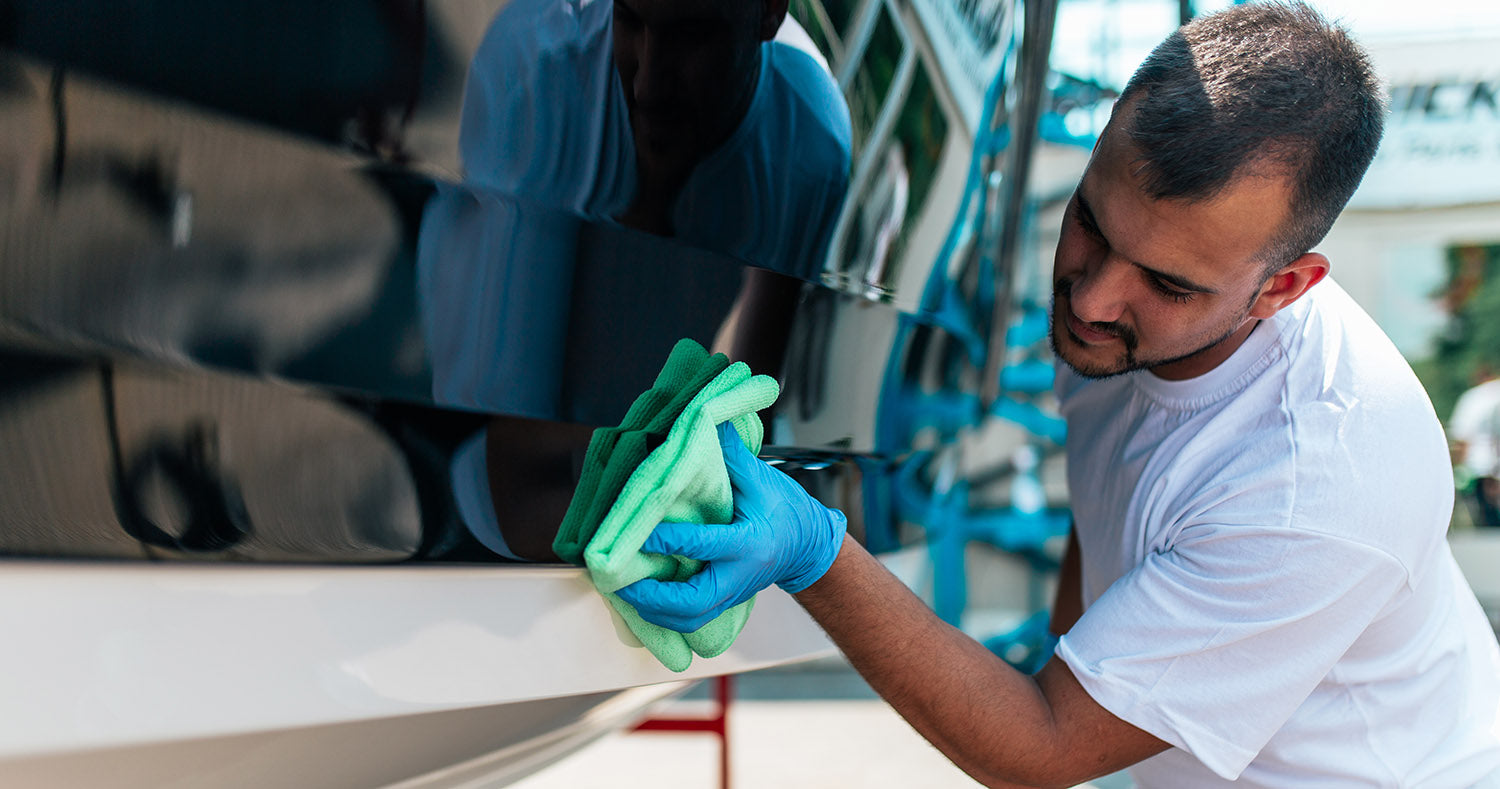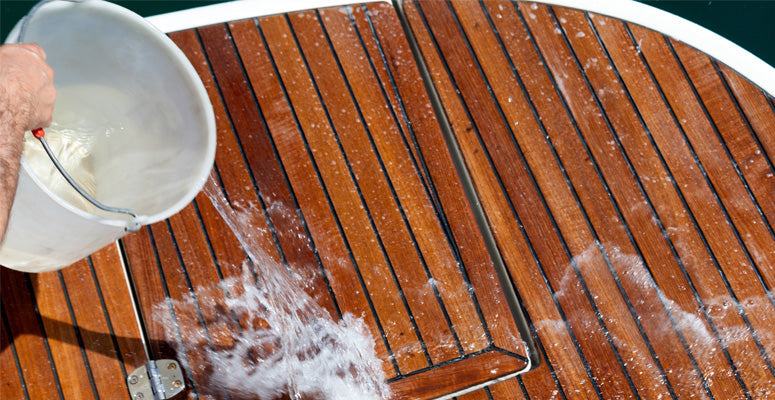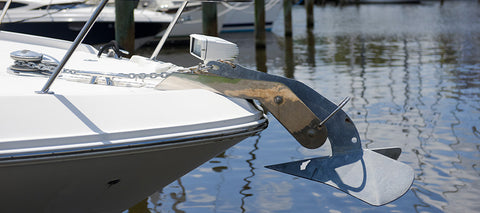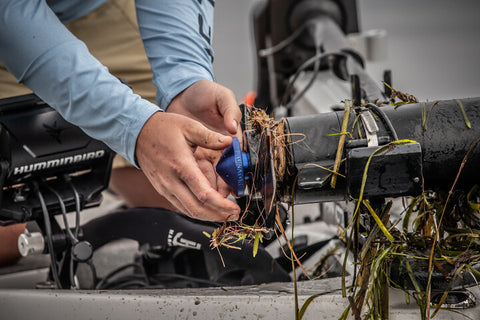Boat Cleaning Guide: Work Smarter, Not Harder

Keeping your boat clean and well maintained isn't just a matter of pure vanity, it's also a great way to improve the longevity of the boat and helps to identify potential problems before they become costly repairs. Boats are exposed to harsh conditions that can often lead to faded paint, dulled fiberglass, oxidized metal, and sun-baked decks. Regular cleaning and detailing will keep your boat looking great and performing at its best.
The Basics
Work Smarter, Not Harder
Some boaters consider cleaning and detailing to be a daunting and back-breaking task. Fortunately for them, it doesn't have to be! While keeping a clean craft is definitely an important aspect of basic boat maintenance, it's not necessary to spend hours on end to accomplish this goal. Sufficient cleaning supplies and regular upkeep go a long way to keep your boat looking and performing great without costing you a fortune.
Choose the Right Cleaning Supplies
To keep your boat shining like new, you need to start off with the right cleaning supplies. You should take inventory of your supplies before you head to the marina to make sure you have everything you need to get the job done properly. You should also be sure to check that the supplies you do have are the appropriate solutions for your particular boat. There's nothing worse than spending hours cleaning your boat only to realize you may have done more harm than good by not paying close attention to your cleaning supplies intended uses.
The most important cleaning supply in your kit should be a quality and eco-friendly marine soap. Marine soap is designed specifically to handle all of the dirt and grime generated by freshwater or saltwater boating. By selecting a good eco-friendly option, you can be sure that you will not end up harming your boat or the surrounding environment while washing away dirt and grime.
In addition to quality marine soap, here are some other essentials that every cleaning kit should have:
- Large wash bucket or two
- Wash mitt or sponge
- 2 extendable brushes (1 soft brush for windows and trim and 1 medium stiffness brush for the hull)
- Microfiber towels/cloths
- Polishing and waxing tools and cloths
- Marine cleaners and degreasers
- Stain removers
- Gel coat protectant (if applicable)
- Vinyl cleaners
Cleaning Your Boat

Rinse, Wash, and Rinse Again
The first step to cleaning your boat should always be a thorough spray of water to remove loose debris and grime from the surface. Never begin scrubbing your boat while it's dry to avoid scratching it. Start at the highest point of the boat and work your way down, moving from the bow to the stern so the water drains out naturally.
Add your soap to a bucket of water and begin scrubbing your boat from top to bottom using either a brush or sponge. If using brushes, be sure to use the appropriate stiffness to avoid harming windows or your boats finish. Thoroughly wash all exterior areas of your boat including your outboard and lower drive if you have them.
Once everything on the exterior of the boat has been cleaned and scrubbed, rinse the boat again to remove any soap suds. The next step is to give everything a good wipe down with your microfiber towels. Hand drying your boat gives it a nice spot-free finish while also removing any residual sediment buildups that wouldn't typically be removed by air drying.
Wax and Polish
In order to protect all of your hard work thus far, you're going to want to add an application of wax or polish to your fiberglass surfaces. Waxes are designed to protect your boat's finish from harmful UV rays as well as to repel dirt and grime from sticking to its surface. While it's not necessary to wax your boat after every use, we recommend performing this once or twice a year to preserve its shine and protect against the elements.
Metal Polishing
After your boat's exterior has been thoroughly washed, give new life to your chrome or stainless metal pieces by applying a layer of polish. A few small dollops of polish will go a long way to ensure your metal railings and trim pieces shine like new. Let the polish sit for 15 to 30 minutes then wipe clean with a rag. This will look great and create a protective barrier against the harsh elements.
Carpet Cleaning
If you share your boat with the family or regularly host guests upon your boat, you will inevitably have spills and accidents on the carpet. Vacuum and spot clean your carpet regularly. A steam cleaner can also be used for those stubborn areas.
Vinyl Surfaces and Upholstery
Vinyl boat seats take a lot of abuse from general everyday use as well as being left in the elements for extended periods of time. Consistent cleaning will help prevent deterioration by removing harmful mildew and contaminants. Begin cleaning your boat's vinyl upholstery with a simple damp cloth. If the vinyl needs extra cleaning power, there are great vinyl cleaner options with built-in UV protection you can use to scrub away stains and protect the surfaces for years to come.
How Often Should You Clean a Boat?
The timeframe between cleanings depends largely on the shape of the boat and how often it is used. If you plan to use your boat often, we recommend washing your boat every couple of weeks. With that said, you don't necessarily have to go through a full cleaning every time. In fact, overwashing your boat with soap could actually break down the wax on your boat. To mitigate this risk, we suggest you rinse your boat regularly with only water to remove trace contaminants and extend the time frame until another full cleaning is needed. All other detail work should be performed on an as-needed basis.
Published
Recent Posts
Windlass Problems? Common Issues and How to Fix Them

Let's look at common issues with windlasses and how to address them:
1) Windlass Won’t Run in Either Direction
2) Solenoid Clicks, but Windlass Won’t Move
3) Windlass Lacks Power to Haul the Anchor
4) Rode Gets Jammed or Doesn’t Come In
Our history: a 20 year journey

Boat Cleaning Tips for Anglers: Keeping Your Vessel Spotless and Pristine

Avast, Ye Mariners! Master the Art of Docking: A Swashbuckling Guide for Boaters

Top Reasons to Keep a Boating Maintenance Log

4 Top Tips for Buying a New-to-you Used Boat

Bent Boat Anchor Shank: Common Causes and Prevention Tips

Prepare Your Boat For An Above Average Hurricane Season

Best Methods For Anchoring Your Jet Ski in Deep or Shallow Water

Best Options For Connecting Your Boat To WiFi Internet
